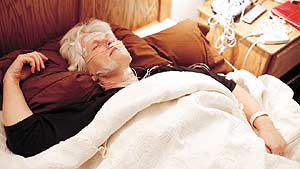 |
Ethical Issues In Hospice Nursing |

PALLIATIVE SEDATION
 For some terminally ill patients, quality aggressive palliative care fails to provide relief. Patients suffering from profound pain, severe dyspnea, intractable vomiting, or other symptoms that do not respond to conventional treatment may choose palliative sedation (PS) as an appropriate intervention of last resort. In hospice and palliative medicine, PS uses sedatives to make a patient unconscious until they die from their illness. Hospice nurses have a responsibility and duty to assure patients that their suffering will be effectively addressed as the fear of suffering compounds the burden of their terminal illness.
For some terminally ill patients, quality aggressive palliative care fails to provide relief. Patients suffering from profound pain, severe dyspnea, intractable vomiting, or other symptoms that do not respond to conventional treatment may choose palliative sedation (PS) as an appropriate intervention of last resort. In hospice and palliative medicine, PS uses sedatives to make a patient unconscious until they die from their illness. Hospice nurses have a responsibility and duty to assure patients that their suffering will be effectively addressed as the fear of suffering compounds the burden of their terminal illness.
The option for palliative sedation should be discussed with patients and families prior to the need for such measures. This allows patients, families, and caregivers to work with the nursing staff to develop a plan of care. This exemplifies the principle of informed consent and upholds the principle of autonomy. If the patient is incapable of making decisions, then the legal caregivers should give informed consent consistent with the desired wishes previously stated by the patient.
However, PS is a precise and risky treatment that leaves a patient unconscious or in a virtual coma until they die. As such, the practice raises ethical issues and concerns about its use among hospice nurses. Yet, the goal of PS is the relief of suffering through the titration of medications to the cessation of symptoms, not the cessation of life (AAHPM, 2010). Many nurses confuse the use of PS for the eminently dying patient as assisted suicide or euthanasia. Palliative sedation is not considered euthanasia or assisted suicide by most medical societies. Furthermore, the United States Supreme Court has ruled in support of palliative sedation as a means of last resort for intractable suffering (AAHPM, 2010).
Human dignity and respect for persons is the foundation of the Code of Ethics for Nurses (Black & Chitty, 2005). These ethical principles are the framework for ethical decision-making that can be utilized to recognize and resolve ethical dilemmas. Registered nurses facing ethical issues in their practice should use ethical decision-making models in determining the best action to take when faced with an ethical dilemma.
REFERENCE
American Academy of Hospice and Palliative Medicine. (2010). Code of Ethics. Retrieved
April 23, 2010, from http://www.aahpm.org.
Black, B. P., Chitty, K. K. (2005). Professional nursing concepts & challenges.
St. Louis: Saunders.
Caliapari, N.(2005). Palliative care: The World Health Organizationís global perspective.
Journal of Pain and Symptom Management. 24(2), 91-96.
Sykes, N., Thorns, A. The use of opioids and sedatives at the end of life. Oncology, 2003;
4(5):312-318.
The American Society for Pain Management Nursing. (2010). Position Statement.
Retrieved April 23, 2010, from
http://www.aspmn.org/Organization/documents/EndofLifeCare.pdf.
The Hospice and Palliative Nurses Association. (2003). Code of Ethics. Retrieved
April 23, 2010, from http://www.hpna.org.
